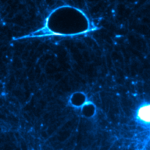Link to Pubmed [PMID] – 26294282
Link to DOI – 10.1111/cmi.12502
Cell Microbiol 2016 Feb; 18(2): 282-301
Botulinum neurotoxins (BoNTs) are responsible for severe flaccid paralysis (botulism), which in most cases enter the organism via the digestive tract and then disseminate into the blood or lymph circulation to target autonomic and motor nerve endings. The passage way of BoNTs alone or in complex forms with associated nontoxic proteins through the epithelial barrier of the digestive tract still remains unclear. Here, we show using an in vivo model of mouse ligated intestinal loop that BoNT/B alone or the BoNT/B C-terminal domain of the heavy chain (HCcB), which interacts with cell surface receptors, translocates across the intestinal barrier. The BoNT/B or HCcB translocation through the intestinal barrier occurred via an endocytosis-dependent mechanism within 10-20 min, because Dynasore, a potent endocytosis inhibitor, significantly prevented BoNT/B as well as HCcB translocation. We also show that HCcB or BoNT/B specifically targets neuronal cells and neuronal extensions in the intestinal submucosa and musculosa expressing synaptotagmin, preferentially cholinergic neurons and to a lower extent other neuronal cell types, notably serotonergic neurons. Interestingly, rare intestinal epithelial cells accumulated HCcB suggesting that distinct cell types of the intestinal epithelium, still undefined, might mediate efficient translocation of BoNT/B.




